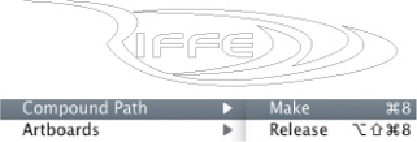Graphics Programs Reference
In-Depth Information
1
The surfboard path outline (top); with the balsa wood image
placed and the path moved above it (middle);
the stacking order of the two objects in the
layers panel before making the clipping mask
(directly above)
2 Creating a complex (compound) clipping mask.
With the surfboard itself prepared, and
since his logo would be used for other purposes, McGarry created the logo in a sepa-
rate document using the Pen tool, Pathfinder panel, and text. He would be “filling”
this logo with a blue underwater image by using the logo itself as a clipping mask.
His initial logo design consisted of two separate paths plus type, all styled initially
with a black stroke and no fill so he could see his design as he worked. Only one path
can be used as a clipping path for a mask, so if you have multiple elements (such as
type and logo objects) you'll have to first combine the elements into a compound
path or compound shape. McGarry had outlined his text so he could make some ad-
justments, so in order for all of the letters and the logo to behave as one mask, he
needed to combine them into one compound path using Object> Compound Path>
Make (
-8/Ctrl-8). Alternatively, if you're working with live type, you can combine
logo design elements and type into a Compound Shape by choosing Make Compound
Shape from the Pathfinder panel.
2
Selecting all parts of the logo and using Object> Compound Path>
Make to create a single compound object
that behaves as one path



